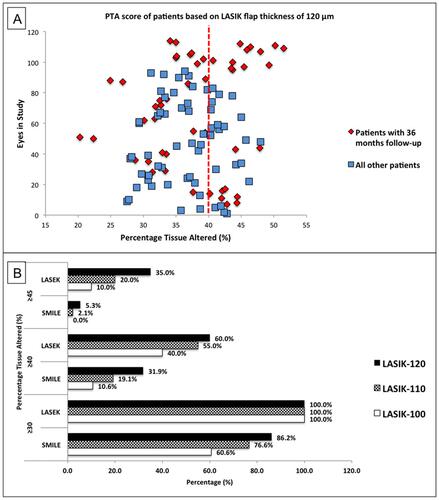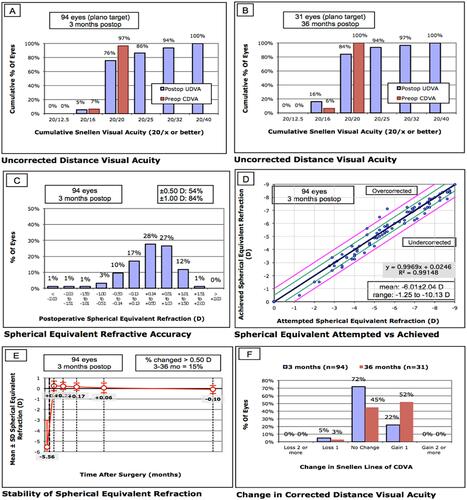Figures & data
Table 1 Pre-Operative Patient Demographics Of All Eyes In Study Who Subsequently Underwent Small Incision Lenticule Extraction (SMILE) Or Laser-assisted sub-epithelial keratectomy (LASEK)
Table 2 Pre-Operative And 3 Months Post-Operative Patient Demographics In Eyes Undergoing SMILE Procedures (n = 94) And LASEK Procedures (n = 20) For Treatment Of Myopia
Figure 1 Percentage tissue altered (PTA) of eyes in study had laser in-situ keratomileusis (LASIK) been performed; these eyes subsequently underwent small incision lenticule extraction (SMILE) or laser-assisted sub-epithelial keratectomy (LASEK) procedures. (A) Scatter plot of PTA based on a LASIK flap thickness of 120μm highlighting patients with 36 months follow-up showing a significant proportion of eyes having PTA ≥40%; (B) bar chart showing the proportion of patients in the study with PTA above fixed thresholds of 30%, 40%, and 45% assuming different LASIK flap thicknesses.

Figure 2 Refractive outcomes of eyes that underwent SMILE procedures. (A) Cumulative percentage of eyes in which the target refraction was zero that attained the specified levels of uncorrected distance visual acuity (UDVA) 3 months after surgery. CDVA = corrected distance visual acuity; (B) cumulative percentage of eyes in which the target refraction was zero that attained the specified levels of UDVA 3 years after surgery; (C) percentage of eyes with post-operative spherical equivalent refractions within intended target spherical equivalent refraction; (D) scatter plot and linear regression analysis of the attempted spherical equivalent refractive change versus the achieved spherical equivalent refractive change at 3 months after surgery; (E) stability of post-operative spherical equivalent at 3 years after surgery; (F) percentage of eyes in which there was a gain or loss of lines in CDVA 3 months and 3 years after surgery.

